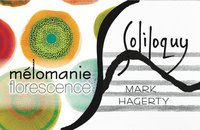By Morgan Silvers
Morgan is a high school senior who enjoys playing sports like field hockey and soccer, and loves spending time with friends. She notes she's happy to have a chance to help write about events and media! In the future, she hopes to pursue a career in either Fashion Merchandising or STEM.
BRANDYWINE BAROQUE
Delaware's ensemble where "early music lives" has
shifted performances into the virtual realm. Currently in the middle of their
2020-2021 Virtual Concert Series, their "Concerts at the Flint
Collection" can be viewed virtually.
Their series includes performances by ensemble and guest artists and features works from their recently released CDs. All performances premiere Sundays at 3:00pm (EST) on Brandywine Baroque's new Vimeo channel.
The ensemble schedule premieres new performances approximately every two weeks. Each performance is about 30 minutes in length and is free to view.
The next concert will premiere Sunday, November 22 at 3:00pm and will feature Brandywine Baroque Artistic Director Karen Flint, performing Pieces in G minor by Jean Henry D’Anglebert on the 17th-Century French Ruckers harpsichord.
To join and view this (and each new) performance, visit https://vimeo.com/475203801. All of Brandywine Baroque’s virtual concerts are available to watch anytime on Vimeo throughout the 2020-2021 season about a day after they have premiered. Be sure to watch!
MARKET STREET MUSIC
Downtown Wilmington's most diverse musical series, Market Street
Music, has moved to an online platform as well. Three performances will be
offered this fall, each in a two-part concert on their new YouTube channel.
Part One of the first performance has already premiered this weekend (Saturday, November 14) and featured cellist Ovidiu Marinescu — a seasoned player of the beloved Bach solo cello suites. In this concert, patrons can enjoy some of those suites along with new music from Ovidiu himself. Part Two premieres Tuesday, November 17 at 7:45pm.
Later this month, Market Street Music presents Marlissa Hudson, soprano and Marvin Mills, piano. These brilliant Baltimore-area musicians perform a program of remarkably beautiful and timely music by Black composers. Part One of their concert premieres Saturday, November 21 at 7:45pm, and Part Two premieres Tuesday, November 24 at 7:45pm.
Finally in December, viewers can celebrate the beloved-by-all Market Street Music tradition — the return of the Cartoon Christmas Trio! This fun-loving trio performs Jazz music from A Charlie Brown Christmas and so much more. Part One of the Cartoon Christmas Trio premieres Saturday, December 12 at 7:45pm; Part Two premieres Tuesday, December 15 at 7:45pm.
Patrons who join at the premiere times can chat live with Market Street Music and fellow patrons during the performance! CLICK TO WATCH!
MÉLOMANIE
For their 2020-2021 season, the ‘provocative pairings’ ensemble presents a series of five 30-minute streamed concerts, called Mélomanie's Virtual Series, putting fans in the 'virtual front row'! Their performances will include the ensemble's signature baroque and contemporary repertoire as well as interviews with guest composers.
Their follow-up concert is scheduled for Saturday, December 12, at 3:00pm.
All concerts will include post-performance "virtual receptions" via Zoom with the artists, and fans can also participate in live chat with each other during performances. After each performance, fans can also enjoy access to full-length, in-depth interviews with guest composers by clicking here.
























